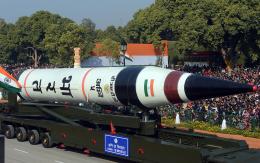Canada set to power India’s nuclear dreams

PHOTO: Agni Missile, courtesy AlJazeera.com
India is all set to receive the first consignment of Canadian uranium in December.
Soon after getting confirmation from Ottawa in this regard last week, India thanked Canada, saying that the move would help the South Asian nation in securing fuel for its nuclear power reactors.
In New Delhi, a senior Indian official said: “the first lot of 250 tonnes of Canadian uranium is already on its on way and should land by the first week of December. Since it is imported fuel, it will be used in the safeguarded reactors.” As per the C$350 million-worth deal signed by the two countries, Canada’s largest uranium producing company Cameco Corporation will supply 3,220 metric tonnes of uranium to India over the next five years.
Although India and Canada signed a civil nuclear co-operation deal in 2010, the North American country was not ready to export uranium and nuclear hardware to India, as New Delhi refused to sign the nuclear non-proliferation treaty (NPT). However, Ottawa changed its mind after Prime Minister Narendra Modi’s visit to Canada in April.
It was an important development, as Prime Minister Modi successfully explained India’s nuclear strategy to the Canadian leaders.
India, which currently has 21 operational and six under construction nuclear reactors, produced a record 1,252 mt of uranium this year, thus, manufacturing almost double of the annual fuel requirement of atomic reactors in the country. Apart from Canada, India is also procuring uranium from Kazakhstan and Russia for its domestic reactors. Even, Australia has agreed to supply nuclear fuel to India.
Nuclear power is the fourth-largest source of electricity in India after thermal, hydroelectric and renewable sources.
In October 2010, India prepared an ambitious plan to reach a nuclear power capacity of 63,000 mw in 2032. However, the country is facing problems in reaching the goal, as people, living around proposed Indian nuclear power plant sites, have launched protests since the 2011 Fukushima nuclear disaster in Japan.
They have raised questions about atomic energy as a clean and safe alternative to fossil fuels.
Meanwhile, India on Nov 26 successfully test-fired its indigenously developed nuclear capable Prithvi-II missile, which has a strike range of 350 km, as part of a user trial by the army.
The missile test was carried out from a mobile launcher from launch complex-3 of the Integrated Test Range (ITR) at Chandipur at 1210 hrs.
Inducted into India’s armed forces in 2003, Prithvi II, the first missile to be developed under India’s prestigious IGMDP (Integrated Guided Missile Development Program) is now a proven technology.
Such training launches clearly indicate India’s operational readiness to meet any eventuality and also establishes the reliability of this deterrent component of the country’s strategic arsenal, army officials said.









